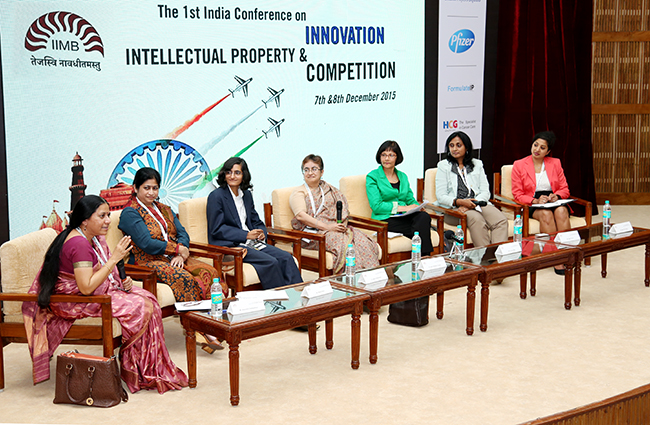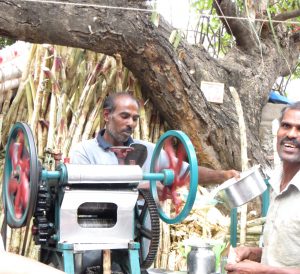ROUND TABLE ON WOMEN AND INNOVATION IN INDIA
Moderator: B. Zorina Khan
PARTICIPANTS: (L-R) Deepanwita Chattopadhyay, Chairman & CEO at ICICI Knowledge Park, India; Debjani Kapila, CoE Leader-Patents and Analytics Center of Excellence, GE Global Research, GE India Technology Centre; Suparna Bhattacharya, Distinguished Technologist at Hewlett-Packard; Kajoli Krishnan, Principal Scientist at GE Global Research; Zorina Khan, Professor of Economics at Bowdoin College and NBER; Deepa Bacchu, Founder and CEO at Pensaar; and Leena Pishe Thomas, Director, Global Business Inroads.
Women as entrepreneurs and employees
Zorina Khan
I would like to start our conversation with Deepanwita, who offers an important message for women. She says “Enjoy whatever you do, keep yourself engaged, open up your mind, think big and embrace the world with its infinite beauty.” Our panelists have made major contributions to technology, some as independent entrepreneurs, whereas others are employed by large corporations and multinational companies. Deepanwita, what do you perceive as the advantages and disadvantages of these different career options?
Deepanwita Chattopadhyay
There are many women employed in large corporations and multinationals doing innovations, but few women entrepreneurs. For example, out of 100 entrepreneurs that we funded, only 7 are women; out of about 400 that I interact with, only 20 are women. The question is, what do women see as career options, what is viable about women in corporations doing innovation and women who are entrepreneurs?
A Harvard Business Review article titled “Women and the Vision thing” reports on an analysis of around 2000 executives from 149 countries enrolled in executive education courses at a university. A 360-degree analysis of their capabilities revealed that women figured as well if not better than men in most capabilities, except for the capability of “envisioning”. The question is, if you do not have the capability to envision things, can you be an entrepreneur, or a leader in your entrepreneurship venture? In a corporation, where there is a lot of competition, can you be an innovator and bring about change — because an innovator changes the status quo. Can you be a leader without realising change, without having the quality of leadership? Leadership and vision are terms that are often seen as interchangeable. How do we see women in a visionary role or is it that they are visionaries but their way of dealing with vision is different?
I come from ICICI, which started Knowledge Park, and where in the middle and top levels, around 40% of the employees are women. The MD & CEO of ICICI Bank is Chanda Kochhar, a woman. We have seen lots of women in the most senior positions in ICICI and within the banking fraternity. But looking at the tech fraternity and its “stem” (i.e. science, technology, engineering and mathematics), are we seeing enough women coming in?
Leena Thomas
At an earlier point of my life I had a lot of ideas, but when I spoke to people much older, they were not able to absorb what I was trying to say. When you are younger, you do not have the required confidence. Maybe, it was something to do with being an Indian; you are always looking to someone older for approval, to give you a push. At that point I felt maybe I am not smart enough, but over time, I met the right kind of people who began to encourage me and say that you are thinking differently on these problems.
Global Business Inroads has been working on technology transfer in climate change, in the technology space, and in life sciences; we are solving social problems, so we have to look at things in a very different way.
As you grow older and wiser, you begin to build your self-confidence. But in the Indian ecosystem, people thought that I was trying to be overly-smart or they could not understand my ideas; I have to thank the US and the US government, as my courage to become an entrepreneur came from there. Though I was just 24 years old when I got my first US government contract to do energy efficiency projects, people who were far more senior than I was appreciated my ideas and work. In the Indian ecosystem, especially for Indian women, it would be nice to similarly have somebody to encourage you and make you think that you can do things far beyond what is thought about today.
Deepanwita Chattopadhyay
I think it is a question of role models. The former chairman of ICICI Bank was always asked this question as to how there were so many women in his organization. He used answer that while hiring we look at merit and not at gender.

Do family firms facilitate efforts by women entrepreneurs?
Zorina Khan
In Abu Dhabi, which I recently visited, if you consider corporations in general, less than 1% of the managers are female; but in family firms women constitute a third of the managers. Do family firms similarly facilitate women’s enterprise in India? I address this question to Kajoli.
Kajoli Krishnan
I cannot say that I have seen technologists come out through family firms. But I will give you one example which is from my own life. When I got married I had finished my PhD, and I moved from IIT Kanpur to Chennai. I had the option of doing a post doc, but I wanted to work for industry. I was on the lookout for somebody with whom I could do practical work or work that had practical application. And I found that my father-in-law was running a company which had a small electromagnetics group and which was working on some interesting problems. I still remember my father-in-law telling me that the problem that had interested him was, when there is an eclipse, can you see behind shadows? It is not completely dark, there is some light. How do you model that light? That is the sort of problem I had to work on and it was so different from the standard electromagnetics that I had been taught in college. That is what I jumped at.
My current career in GE, it has been about 15 years, but I think if I had not spent a 10-year stint working with Prof. Krishnan Sr, learning how to do industrial physics, I would not have got the GE job or had the very interesting career in GE that I have now. Because the way we get trained to do physics in India is very stereotypical. I was yet to meet somebody with my kind of background to have studied completely in India and doing what I am doing now. I don’t know if you call it a family firm but it made a huge difference to me.

Woman weaving rope from coconut coir in Kerala, India
Incentives for innovation
Zorina Khan
One of the main reasons why the US succeeded in the world economy was due to what I call the democratization of invention, where disadvantaged individuals were offered incentives to make contributions based on their own creativity. These benefits motivated greater efforts by poor inventors, by women, and minorities, in ways that differed from inventive patterns in European countries that did not believe in the creative possibilities of non-elites. It is fascinating to observe inventions by women in the US. Generally, their inventions aim to make life easier for themselves and their families. One of my favorite female inventions is one that combined a washing machine with a see-saw; when the children played it automatically washed their clothes.
Deepa, could you highlight policies in India that can encourage participation of the poor in technology and innovation. How can ordinary people and inventors make a difference in India?
Deepa Bachu
I think it is important to have the government’s support. Several people on the previous panels today spoke about incubators. It is very important for people to have access to funds. The second thing is to know what areas to focus on. Third, and possibly the most important, is ensuring that we have enough innovation capacity. India has a lot of really good initiatives by the government and the private sector to help fund and provide resources to innovators.
Still, our global innovation index is falling and in the past 10 years, it has fallen about 10 points; it is 76 out of 143 countries. On the one hand, India is an amazing country with very smart individuals who study the sciences. If we look around, especially in cities like Bangalore, everyone wants to be a startup entrepreneur. It leaves me thinking, what is the gap then? I feel that as engineers we are so focused on solving the problem, that we fall in love with the solution at the expense of the problem. We get so attached to the solution then even if it is incremental or mediocre, we do not take the necessary step forward. It is very important to think about our ability to innovate and also our capacity not just for incremental innovation but to leap frog and come up with unbelievable solutions.
Finally, the big trap we all fall into is the situation when we have this really large vision and we feel we have to get it done all in one bite. We must bite-size our vision and think about disruptive ways to get quick feedback from customers, and iterate with customers.
As far as policies are concerned, one thing that is doing really well is the Startup Village which is a government and private partnership; one of its activities is teaching children to innovate. It encourages them to be curious, gives them gadgets and helps them go beyond thinking incrementally. One of the other programmes enables you to get your Bachelor’s credits for entrepreneurship. There is also a means of tracking people who have gone through the programme and who are creating inventions that matter. An interesting invention I saw was a sort of a step stool that grows by itself where people can pluck coconuts or papayas without having to climb a tree. So, it is these little innovations that make a big difference. It starts with children questioning things rather than accepting what is given.
Suparna Bhattacharya
That’s a question in my mind as well, about our education system, where you are probably taught scientific principles and how to do analysis with it. But the question is, how do you create things? This was a big learning for me during my working career — How to go from analysis to synthesis? What you are pointing out is that you can do synthesis very early in life — if you have the right incentives. That is a very interesting perspective.
Deepanwita Chattopadhyay
Are there any policies or incentives for women to do innovation in India? I am not sure that there is one directed towards women and innovation. I know that there is a science park, or an incubator for women in Chennai, the Golden Jubilee Biotech Park for Women. However, women tend to concentrate on the low-hanging fruits, the low end of the tech innovation. I was part of an effort from the Department of Biotechnology to see if women could be drawn into high tech modern biology or mid tech kinds of innovation or entrepreneurship. Of course, innovation and entrepreneurship are not synonymous. We all realize that but in order to devise schemes for women, we may try and combine things which may not be at the best level possible.
I remember reading an article about women who have taken a break from their career and are given an option of patenting or writing patents. Actually, the Technology Information Forecasting and Assessment Council (TIFAC), the organization that looks ahead in technologies, assesses the technology trajectories, and supports technology innovation, has done that and it is a career transition option provided to women. There are also scholarships available for women who have taken a break and there is a mid-career comeback but I am not sure of the uptake and whether it is really helping women get on to a career that is meaningful.
We need to see whether there are any policies that are possible to give special encouragement to women entrepreneurs, but I do not see any. I do not believe in giving anything special to anyone. If you are good you are good; you will be acknowledged. That may be because I come from a background where I have got things and from a family where I have enjoyed all the benefits and support. Whether the same applies to people who are not as advantaged is something to be debated about.
Debjani Kapila
The very first thing that women lag behind in is in sheer number. The number of women reaching a stage where they have the technical or professional ability to invent is very small. When we talk about low-hanging fruits, I feel that we have to look at quality versus quantity. We always question whether quantity is better than quality. But, I think we need to have a sufficient number, a certain quantity to get better quality. We have to exercise that judgement.
Zorina Khan
One of the participants in the audience today told me that he wanted to see fireworks. So, here are the fireworks: I completely disagree with what you are saying. I think that ordinary people have the ability to see what they need and to make innovations that are going to expand the boundaries of their own lives, without having a PhD degree, without being employed in a corporation. All they need are incentives, and the key question is whether those incentives are being provided. I want to ask Debjani about the reason for the gender gap that exists in the whole process of invention through its innovation, and in particular why this gap is especially prevalent at the critical point of commercialization.
Debjani Kapila
If we look at women in invention, innovation and specifically commercialization, there are several factors that matter. Let us begin by looking at how many patents women are filing. I could not find data pertaining to India, but on an average, the percentage of women filing for patents in the US or at least patents with one inventor being a woman is 8-10%, in Germany it is 5%, in Israel it is 2% and my gut feeling is that in India it will be 1% or below. If I look at 2013 data, we have filed around twenty-thousand patents and in the US it is around five hundred thousand patents.
My question is, where is the problem coming from? Is it right from the beginning when we start our journey or is it somewhere up in the value chain? I looked back and did some backward thinking. The starting point is the skewed sex ratio; for every 1000 male children born, there are 930 women. I looked at the Ministry of Human Resource Development (MHRD) data of enrolment of girls in school, especially in primary and secondary school — I was expecting quite a difference, but surprisingly, in primary and secondary school, it varies from 0.9 and 0.8 respectively, with respect to boys which is not bad at all; in higher secondary school, it goes up to 0.8 which is again not bad. The question is, where is the gap? The first leakage is during graduation. When I looked at the data, only 3% of the women enroll into engineering. If you look at UGC data, 1.6% of women graduate from engineering colleges, and the percentage for post-graduation is 0.16%.
Coming back to Zorina’s point, that innovation does not depend upon degrees, there is some indication that if you have an engineering degree and some experience, you do have more patents to your credit when compared to the others.
There are some psychological factors for the gap. As part of a survey, when we went to primary schools and asked students to draw a picture of an engineer, more than 80% of them drew the picture of a male. Maybe that is what they see. So, that is the perception they get from the very beginning. Then, there is a general presumption that if girls take mathematics, their success rate is very low. Further, when a girl is not able to succeed, she feels “it is my problem, there is a problem with my capability.” When a boy does it, then it is a systemic problem. But, the advantage is that boys do not give up and they think that it is the system’s problem. But, girls give up. The changes have to take place at different levels. I am not talking about corporate-level work-life balance, child bearing, and associated issues — we are familiar with those issues, but these other changes have to start at home and we have to have more discussions on those issues.
Deepa Bachu
I spent 20 years in technology and every so often I realize that I have forgotten I am in an environment where I am the only woman. While education is important and I am a big proponent of it, what is important is for us to be curious in general and to inspire that curiosity throughout the education system. I feel it is very important for each one of us as women leaders to sponsor other women. You spoke earlier about role models, and that is really important. About five years ago, I used to mentor people. I realized that sponsorship is so necessary where you are ready to stick your neck out for someone else. We cannot wait for our children to develop the required level of confidence. We have to work with what we have right now and do both simultaneously, and focus on sponsoring women.
 Slogan on wall, Kerala, India
Slogan on wall, Kerala, India
The challenge of commercialization
Zorina Khan
Deepanwita, I am certain that you have some really interesting perspectives about commercialization.
Deepanwita Chattopadhyay
In commercialization, in general, I see that especially on the technology side, people are good at solving a problem, doing proof of concept, the first prototyping is also fine; but development and commercializing is the main issue — that is where they falter. Most startups cannot make it at that point.
In a group of about three co-founders where one person is a woman and the other two are men, generally, I see the woman is very assertive and the group is able to work very well. I hardly see a single woman starting a company and making it go beyond a certain point. I think in any case, you need co-founders, you need a team that is well-balanced, that is diverse, where there is gender diversity, and where men and women work together.
Another thing is if the field is chemistry, medicine, biology or even finance there are more women; in mechanical or electrical engineering there are far fewer women. This is not only in India, but in most other countries. If you look at the US inventors list, out of 500 names, there only 4 women and 3 are in chemistry. Chemistry and medicine have always been a strong point for women. However, there have been women who have invented, but not as technologists. For instance, Bette Nesmith Graham was a typist and she invented Whiteout which was used to cover typing mistakes; it was a necessity and she invented it. The dishwasher was invented by a woman. But in formal education, I have not seen a lot of women in other disciplines apart from medicine and chemistry.

Kajoli Krishnan
I have felt that it is not just about women in general. I think inter-disciplinary teams or individuals who have crossed the boundaries between fields, between groups or countries or cultures, are usually far more innovative. They think differently, do things differently; maybe they are more sensitive to the environment. So, they think of more ideas and do more disruptive things. That is number one.
Number two, the question of the business of commercialization, taking from prototype to product, my experience of the “men versus women” question (if I can put it that way) is that, first, it is difficult for both. It involves not only understanding the technology but it is also about the process of negotiation even in a large organization where there is a prototype and you want the business to pick this. You need tremendous energy and perseverance to go on and on having the necessary dialogues and sometimes people get tired and give up. Men also give up. So it is a combination of understanding the technology, having patience and the dream to persevere — all of this has to come together.
Suparna Bhattacharya
On the point of vision, is it that people lack vision or that for you to be perceived as having vision, you need to be able to go through the fight to get your idea across?
Kajoli Krishnan
I suspect that it may be true across the board and maybe that is where entrepreneurial activities are different from companies. In companies, the affirmative action initiatives encourage and enable women to grow into leadership; the growth for women has always been in leadership. What happens in this process is that women stop being engineers. When you go into management, you stop being an engineer. So, the role models you see are great leaders, great managers, but you lose women doing hard engineering, and that is a loss.
Leena Thomas
My hope and dream for India came from what I observed while doing a project with the European Commission. There is an entity called the EU Climate-KIC funded by the European Commission and they work very closely with universities across Europe and they also work to help fund ideas. When these ideas pass a certain stage, they get them the next level of funding until the time the projects go up to venture capital funding. So, we have helped some of those technology companies to come into the Indian market. In Europe there are strong networks for women entrepreneurs or for women in innovation. I have been part of couple of the conclaves and it is fantastic to see the kind of camaraderie there is.
Can we build these kind of innovation ecosystems in India? If, in India, there had been innovation ecosystems or similar programmes in my university encouraging entrepreneurs or where there were networks for women entrepreneurs, I might have had the courage to start doing things on my own much earlier in life. In Europe and the US such forums have been long established. In Europe, the European Business and Innovation network (EBN) was set up 30 years ago. I think we should talk about what we should do in India to build these kinds of innovation ecosystems.
I think it is important to get women to share. Instances abound of women having given up their careers, for various reasons. Their approach in general is reactive rather than proactive. There are two reasons for this: One, is the education and lack of an innovation system; and second, and the most important in India, is family support. How many women in Indian get their family’s support? You and I do. It is such an important part of an Indian woman’s life for sure. These factors should be thought about; there definitely needs to be a mindset change, there needs to be an ecosystem change.

Kerala Backwaters
Different routes to innovation
Zorina Khan
Suparna, you have dealt with open source and worked for IBM, and you were heavily involved in the development of software and intellectual property (IP). Please give us your views on the debate about open source as an alternative model to IP.
Suparna Bhattacharya
I am rather passionate about open source. I have tried different kinds of routes to innovation. One is patenting and doing IP, creating patents and inventions. The other one is scientific research. I spent my time in IBM in research and I had the experience of publishing papers. The third avenue I found was open source and it is the most surprising avenue of all.
When I started working on open source under the Linux Kernel packet in 2000, it was because I had the opportunity. IBM was starting with its Linux technology centre and I had worked under several proprietary operating systems. I looked forward to having access to the entire code and playing with it. I did not expect that what I do would be innovative. In fact, some of the things we were doing at that time was to make Linux work well for enterprise resource and those features existed in other operating systems. So when we started working on Linux, I thought it would be very similar and it would be fun to code.
However, what I realized – and this is the power of the community – was that Linux had its challenges; and it was typical of open source software because it runs on a wide variety of platforms and is used by a wide range of people. You need something that can run on a cellphone as well as a super computer, and also a mainframe, and that imposes very diverse kind of requirements. The traditional ways we did things would not work, for someone or the other in the community would point that out or there would be silence when you posted on the forum. This plays an important part in the process of ideation that leads to innovation — we were talking earlier about being exposed to different areas and different perspectives. One of the things that surprised me as I was working on open source, was the variety of ideas that it results in.
On the other hand, as somebody pointed out, with patents there is an emphasis on novelty, on doing something differently from what was being done before. Patents force you to think and distill what is new and put that across. Open source had this other benefit in that if you have ideas, the process of realizing the ideas, developing something from scratch is difficult but if you have tools out there, if you have source out there, if you have some sort of open source or you have open access to data, then it helps. If you are doing software engineering research, then the whole bunch of open source out there is all your data. These help you drive down the cost no matter where you are sitting. And I felt that we should have seen a lot of women in open source.
Zorina Khan
I have done some empirical research on open source, and find that fewer women are involved in open source than in patented technologies. For instance, in a sample of 1000 individuals contributing to open source, only 2% are women. Why are women even less represented in open source innovations, where one might assume barriers are lower, than in patent systems?
Suparna Bhattacharya
That has been also my experience with the Linux Kernel Summit. I used to be the only woman in the room for several years. I was looking at last year’s Linux Kernel Summit and there were three women in the picture, which was a progress. Because of that, I had always been asked personal questions. Like many of you said, I have not faced any barriers, but have received support from my family, my colleagues at work, and my open source community. I never thought I was any different. I feel, in general, to raise an idea and to raise innovators it takes a village and you are lucky if you have a village by your side supporting you. In my case, when I started participating in the community, I had members from the community who did not know who I was, they did not know what my gender was or what area I worked in, but they still went out and helped me.
Every time I went to a Linux conference, there would always be this question, why so few women? Some people would volunteer that maybe there are certain kinds of things women are good at — so let us give them the ability to do those kinds of things. Thankfully, those opinions were sidelined. Or there was this suggestion that perhaps women were not interested in certain areas. I agree with what Leena said — instead of debating why that is so, we must try to do something to actually improve the situation.
In the last few years there has been an interesting development a — Free and Open Source Software (FOSS) outreach programme for women, which announced stipends and internships for women across a variety of FOSS projects and this has sponsorships for many companies. In order to apply for the internships, you need to get your code accepted into the main line open source stream; that is how you apply in the first place and then you are assigned a mentor and you get to work on projects with the mentor and contribute to the community. They would run this cycle twice a year and each time they would induct six interns or so. In the Linux foundation’s last Linux Kernel Development report, when there were three cycles and so 24 people coming into the kernel community, when you looked at the collective contribution across kernel versions, these people now as a group were one among the top 15 contributors to the Linux Kernel. So what that shows is it is not just a question of interest or ability but it is also having the right support and ecosystem that works.
Debjani Kapila
At GE, we started a small initiative, which is led by women. We are going to different schools, inviting them for a term of 3-4 months and taking them through different labs. We are showcasing some of the most interesting technologies to develop their interest. So far, there has been good participation. A second programme is one called “Restart” for people having a gap of 6-8 years in their carreers who would like to come back. I think we have a small success there, not full success. Finally, we are coming back to the same thing. We ourselves have to create the ecosystem rather than asking somebody else to make the change.

Government – industry partnerships in innovation
Zorina Khan
That is exactly the point about which I wanted to talk to Kajoli. Kajoli works at GE in the area of very critical technologies. Her research shows how access to ultrasound can lead to vast improvements in maternal and foetal health. But in most other countries, such issues are dealt with through public health organizations. So Kajoli, can you discuss the relationship between the government and industry in such key innovation areas, especially in relation to sensitive issues like women’s health and well-being?
Kajoli Krishnan
Many of you would be familiar with the UN Millennium Development goals. Among them is the goal of reducing infant and maternal mortality. About six years back, I was part of one of these programmes in GE. Ultrasound is used extensively in imaging, and with pregnant mothers throughout the gestation period to make sure that the foetus is growing healthily. There are two aspects of note in ultrasound. One is, the imaging is non-intuitive because it is a two-dimensional presentation of what you want to look at. When you move an ultrasound probe on the belly, a little movement causes a lot of shift in what you see. In India, an ultrasound device can only be used by registered medical doctors. Since ultrasound is non-intuitive, you need to bring up particular kinds of images and there is a way to take measurements with a caliper which is on the scanner; so, that process takes time.
There is a certain level of complexity in the workflow, which for experts is fine, but for relatively new users, it is slightly more complex. One of things we realized we could do is simplify the workflow. I was involved in a project where we were simplifying the workflow. We were automating the measurement process by using computer-assisted algorithms and so we built those features and now it sits on many of our scanners. During this process we spent a period in an immersive environment. In the process, I found two things — the fact that the company was responding to a need which was social, was itself good. So, in answer to your first question — companies could and should respond to social needs. But what it can finally do with those innovations depends a lot on the regulatory framework in a country and the kind of partnerships you can build with the government.
Some of the features we developed are actually being used more in places like Bangladesh and Indonesia because those are countries where midwives and paramedics have traditionally taken care of pregnant women. For the past 20 – 30 years there is a fabric of midwives to care for pregnant women. Now if you train these women to do ultrasound scanning, and teach them to take these measurements you are actually driving that innovation and also driving commercialization by working with the government.
Some of these things that we designed are used by experts, but the place where we made maximum impact could be in some other part of the world because there the ecosystem or the regulatory framework allows the best use to be made out of these technologies. So my answer to your other question is — yes, they could work together and make a difference; but they should be sensitive to the regulatory framework, and what happens finally depends on that. Again, as a researcher when you spend some time in an immersive setup where you watch how people do things, you do your research and innovation more effectively.
Zorina Khan
We are getting close to the end of our conclave. I want to turn to Leena. She has had the opportunity to work with teams in India, France, Sri Lanka and many other places. Now, this is an exciting time to be in India, as imported technological developments are creating advances for the Indian population, and domestic innovations created by Indians are also having an impact on the rest of the world. Could you briefly tell us about the opportunities and challenges that face Indians in the international sphere?
Leena Thomas
Our business is traditionally focused on bringing technology from the US, Europe and other parts of the world to India. In the last couple of years, we have been asked by some international and Indian ecosystems to look at how we could help the Indian entrepreneurship ecosystem, incubators and their entrepreneurs to connect with other international ecosystems. We connected with some very good networks in the US Silicon Valley and in Europe. In Russia, there is the Skolkovo Innovation Centre, there are innovation centres in Colombia and Brazil as well.
We are now in the process of doing road shows by these foreign clusters in India; there was one with UC Berkley and a recent one with US Market Access Center Inc. (USMAC) in Bangalore, where we planned to meet several incubators to understand which technology entrepreneurs and incubators would want to connect with international markets, investors, ecosystems, and so on. We are planning another one with the European Business and Innovation Network. So, it is also a good time for Indian startups, entrepreneurs, universities to start giving their students and themselves international exposure, which is very relevant to product development and growth today.
So the opportunity exists, but there are also challenges. On one hand, we have seen that the incubators and innovators are very excited because of the market opportunities, access to mentors, and investors; design specialists too could be tying up with other markets for product co- development. But the question is, as Suparna was saying, there is complete lack of process and funding. When we ask people do you have the process, do you have the funding, they say if you give us the process, we can go to the government and get the funding. We are actually doing that. We have foreign experts who work with these organizations to customize road maps, which the organizations build and take to the government. But, it is a huge challenge because it is something new that we are doing. We have been doing this for the last two years and we do not know if this is going to be backed and supported by the right kind of funding sources. We have also gone into discussions with corporates in India to see if they want to encourage these entrepreneurial ecosystems and support these kinds of activities.
In Colombia, Medellin has emerged as a region with strong programmes for funding for product development, and for market access. They are all structured and managed well. It would really be very interesting to work with all of you here to convert the challenges we are facing in India, and turn them into real opportunities for Indian entrepreneurs.
Zorina Khan
Mahatma Gandhi is said to have proposed that “we must be the change we wish to see in the world.” It is clear that the extraordinary members of this panel have taken this dictum to heart. It has been a privilege to have this conversation with you all.
The members of this panel have been discussing key issues that are exciting and important for innovation and socioeconomic progress. The benefits of engaging women in such conversations are very evident, and we hope that exchanges like these will continue in the future.

Chand Baori stepwell, built in the 8th century, in Abhaneri, Rajasthan, India.
Stepwells were likely used primarily by women. This well descends for 13 stories (about 100 feet in depth), to reach the low water table in the drought-prone region. Stepwell technology, developed since 3000 years BC, required advanced mathematical and engineering skills.
[The Conclave on Women and Innovation in India was part of the India conference on Innovation, Intellectual Property, Competition, December 2015, IIM Bangalore.]